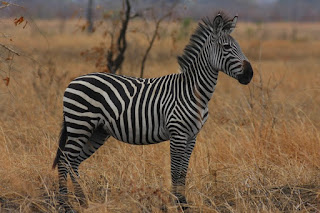Tanzania is famous for its big mammals and safaris, however it also offers an amazing set of endemics to the birders besides the East-African avifauna that can be seen on the standard Northern Circuit (Serengeti, Lake Manyara, Ngorongoro crater and Tarangire). We did not want to miss a real Tanzanian safari so we opted for a combination of Safari and the Eastern Arc Mountains, which hosts the most endemics in Tanzania and is actually the second most biodiverse region of entire Africa.
Our choice for the Safari was Mikumi National Park, which is due to its lack of fame reasonably priced, but still offers some decent mammalwatching. We were lucky enough to find some people who wanted to share a 4WD with us so we paid 50 Dollar for the vehicle and 20 Dollar each for the National Park.
Our safari was a big succes, for we saw 15 species of mammals including Lions, African Elephants, Common Zebra's (I don't know which subspecies, probably
boehmii or
crawshanki or something in between), Hippopotamus, Masai Giraffe, African Buffalo, Bridled Gnu, Eland, and Impala. Less spectacular , but still really cool, species included Bohor Reedbuck, Bushbuck, Yellow Baboon, Slender Mongoose, Black-backed Jackal and Common Warthog. Also two Nile Crocodiles were noted.
 |
| Yellow Baboon (Papio cynocephalus) |
 |
| Blue Wildebeest (Connochaetus taurinus) |
 |
| Black-backed Jackal (Canis mesomelas) |
 |
| Masai Giraffe (Giraffa camelopardalis tippelskirchi) |
 |
| Young Impala (Aepyceros melampus) |
 |
| Bohor Reedbuck (Redunca redunca) |
 |
| African Elephant (Loxodonta africana) |
 |
| Common Zebra (Equus quagga) |
 |
| African Lion (Panthera leo) |
Besides the spectacular mammals, this park also offers some really good birdwatching. The Hippo-pools proved good for several waterbirds such as Hamerkop, Yellow-billed and Saddle-billed Stork, African Spoonbill, African Fish-Eagle, Water Think-knee, Blacksmith Lapwing, Three-banded Plover, Marsh Sandpiper and Little Stint. The park is also really good for raptors as eleven species were recorded including: Hooded, Palmnut, African White-backed and Lappet-faced Vultures, Booted and Steppe Eagles, Black-chested Snake Eagles. Bateleurs were ever present and a pair of Grey Kestrels was a bit of a surprise.
 |
| Tawny Eagle (Aquila rapax) |
 |
| Bateleur (Terathopius ecaudatus) |
 |
| Crappy record shot of a Lappet-faced Vulture (Torgos tracheliotus) |
 |
| Grey Kestrel (Falco ardosiaceus) |
The plains proved also good for several species as Southern Ground-hornbill, Black-bellied Bustard, Helmeted Guineafowl, Red-necked Spurfowl, Temminck's Courser and Yellow-throated Longclaw were all much enjoyed. The scrubs held a whole different set of birds and species like Little Bee-eater, Northern Pied Babbler (Tanzanian near-endemic), Scarlet-chested Sunbird, Black-crowned Tshagra, Long-tailed Fiscal, Southern Blue-eared Starling, African Firefinch and Fan-tailed Widowbird.
 |
| Temminck's Courser (Cursorius temminckii) |
 |
| Black-bellied Bustard (Lissotis melanogaster) |
|
|
|
 |
| Helmeted Guineafowl (Numida meleagris) |
 |
| Scarlet-chested Sunbird (Chalcomitra senegalensis) |
I can recommend Mikumi National Park to anyone who is looking for a safari in Tanzania as it is reasonably priced but still has a lot of wildlife and it is easy to reach from Dar es Salaam. Even the busride is very worth doing as the the bus passes through the National Park and African Elephants, Masai Giraffes, African Bufallos, Common Zebra's and Impala's can all be seen from the bus.
Mikumi town itself is quite uninteresting, however we managed to see two very interesting birdspecies here: a Walhberg's Eagle flew over our tent both days we stayed there and one night we observed a displaying Pennant-winged Nightjar, which was as incredible to see as all the big mammals we saw that day!
 |
| Migrating juvenile Bee-eater (Merops apiaster) |



